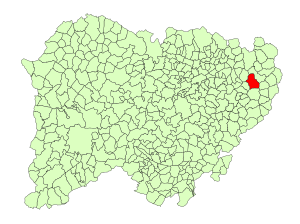Villar de Gallimazo facts for kids
Quick facts for kids
Villar de Gallimazo
|
|
|---|---|

Location in Salamanca
|
|
| Country | Spain |
| Autonomous community | Castile and León |
| Province | Salamanca |
| Comarca | Tierra de Peñaranda |
| Area | |
| • Total | 44 km2 (17 sq mi) |
| Elevation | 855 m (2,805 ft) |
| Population
(2018)
|
|
| • Total | 201 |
| • Density | 4.57/km2 (11.83/sq mi) |
| Time zone | UTC+1 (CET) |
| • Summer (DST) | UTC+2 (CEST) |
| Postal code |
37320
|
Villar de Gallimazo is a small town, also known as a municipality, located in the province of Salamanca, which is part of the Castile and León region in Spain. As of 2016, about 202 people live there. It's a quiet place in the Spanish countryside.
Contents
Exploring Villar de Gallimazo
Villar de Gallimazo is a charming municipality in western Spain. It's part of a larger area called the Tierra de Peñaranda. This region is known for its traditional Spanish villages and beautiful landscapes.
Where is Villar de Gallimazo?
Villar de Gallimazo is located in the province of Salamanca. This province is in the Castile and León region, which is one of Spain's largest areas. Spain is a country in Europe.
The town is situated in a part of Salamanca called the Tierra de Peñaranda. This area is made up of many small towns and villages.
How Many People Live Here?
In 2016, the population of Villar de Gallimazo was 202 people. This means it's a very small community. Imagine a town where everyone probably knows each other!
What is the Land Like?
Villar de Gallimazo is located at an elevation of 855 meters (about 2,805 feet) above sea level. This means it's quite high up. The total area of the municipality is 44 square kilometers. That's about 17 square miles.
Who Leads the Town?
Like many towns, Villar de Gallimazo has a leader called a Mayor. The current Mayor is Sergio González. He belongs to a political group called the People's Party. The Mayor helps make decisions for the town.
Time in Villar de Gallimazo
Villar de Gallimazo uses CET during most of the year. This is UTC+1, meaning it's one hour ahead of Coordinated Universal Time. In the summer, they switch to CEST, which is UTC+2. This is also known as daylight saving time.
See also

- In Spanish: Villar de Gallimazo para niños
Images for kids


